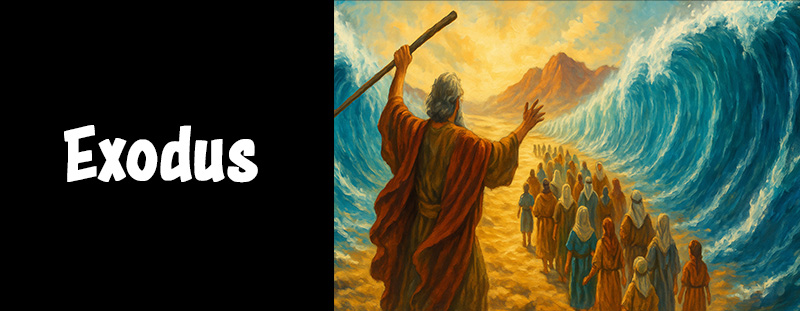⛺ The Dwelling Place of God Among His People ⛺
“Moreover thou shalt make the tabernacle with ten curtains of fine twined linen, and blue, and purple, and scarlet: with cherubims of cunning work shalt thou make them.” – Exodus 26:1 (KJV)
Exodus 26 reveals the intricate design of the Tabernacle, the sacred dwelling place of God among the Israelites during their wilderness journey. Every measurement, color, and material carries deep spiritual meaning—pointing to God’s holiness, order, and desire to dwell with His people.
This chapter continues God’s detailed instructions to Moses, focusing specifically on how the Tabernacle itself should be built. It emphasizes not only craftsmanship but also divine precision. Through this, we see how God uses both artistry and obedience to establish His presence among His people.
📜 Structure of Exodus Chapter 26
Verses 1–6: The Ten Curtains of the Tabernacle
God instructs Moses to create ten curtains made of fine linen, beautifully embroidered with cherubim in blue, purple, and scarlet thread. These curtains symbolize purity, heaven’s glory, and divine protection. The curtains were to be coupled together by loops of blue and golden clasps, joining them as one—reflecting unity in divine purpose. The artistry and precision reveal that worship requires both beauty and obedience.
Verses 7–14: The Coverings for the Tabernacle
Over the linen curtains, God commands additional layers: coverings of goat hair, ram skins dyed red, and a final outer layer of badger or seal skins. Each layer provided both beauty and protection. Spiritually, these coverings symbolize God’s layered grace—His covering over sin, His protection from the elements of judgment, and His provision for those who dwell under His covenant.
Verses 15–30: The Boards and Bars of the Tabernacle
The structure of the Tabernacle was to be made from acacia wood—sturdy and enduring—overlaid with gold and held together by silver sockets. The gold represented divine holiness, while silver symbolized redemption. Every socket, board, and ring carried purpose, showing that God values order and precision in His dwelling. The wooden framework reminds us that God’s presence is both glorious and grounded—a holy dwelling in the midst of human fragility.
Verses 31–33: The Veil and the Separation
The veil, made of blue, purple, and scarlet linen with cherubim woven in, divided the Holy Place from the Most Holy Place. Behind this veil rested the Ark of the Covenant, where God’s presence dwelled. This separation was crucial—it represented humanity’s distance from God due to sin. Yet, through Christ, this veil was later torn (Matthew 27:51), granting believers direct access to God’s presence.
Verses 34–37: The Inner Arrangement and the Entrance
God’s final instructions focus on the placement of sacred objects—the Ark behind the veil, the Table of Showbread, and the Lampstand before it. The entrance curtain, like the inner veil, was beautifully crafted with vibrant colors and supported by five pillars. This outer entrance symbolized invitation—God welcoming His people to draw near, though with reverence and obedience.
💡 Key Themes
✨ God’s Presence and Holiness
The Tabernacle demonstrates that God desires to dwell among His people—but on His holy terms. Every detail emphasizes His holiness and the need for purity in His presence.
✨ The Beauty of Divine Order
Nothing in Exodus 26 is random. Each loop, clasp, and thread has purpose. God is a God of order, and His instructions show that obedience and precision in worship matter deeply.
✨ Foreshadowing of Christ’s Redemptive Work
The Tabernacle points forward to Jesus Christ, who became the true dwelling place of God among humanity (John 1:14). The veil, later torn at His death, signifies that through Him, we now have full access to the Father.
👤 Key People
- Moses – The leader and prophet who received God’s detailed blueprint for the Tabernacle.
- Bezalel and Aholiab (implied in later chapters) – Skilled craftsmen chosen to bring God’s vision to life.
- The Israelites – Called to give, serve, and build according to divine instruction, participating in God’s holy dwelling.
🔥 Why This Chapter Matters
Exodus 26 reveals God’s desire for a sacred relationship with His people. The Tabernacle was more than a tent—it was a mobile meeting place between heaven and earth. Every detail whispered of God’s holiness, grace, and coming redemption through Christ.
For believers today, it’s a reminder that God still seeks a dwelling within His people. When we live in obedience, purity, and reverence, we become living tabernacles of His Spirit.
💭 Let’s Reflect
- What does the precision of God’s instructions teach you about His nature and expectations?
- How does the tearing of the veil in the New Testament change your understanding of God’s accessibility?
- Are there areas in your life where God is asking you to “build” according to His pattern rather than your own plans?
❓Ready to Go Deeper?
👉 Click here to begin reading Exodus Chapter 27
Or, if you’d like to jump to a specific chapter in Exodus, simply click the chapter number below:
1 | 2 | 3 | 4 | 5 | 6 | 7 | 8 | 9 | 10 | 11 | 12 | 13 | 14 | 15 | 16 | 17 | 18 | 19 | 20 | 21 | 22 | 23 | 24 | 25 | 26 | 27 | 28 | 29 | 30 | 31 | 32 | 33 | 34 | 35 | 36 | 37 | 38 | 39 | 40

